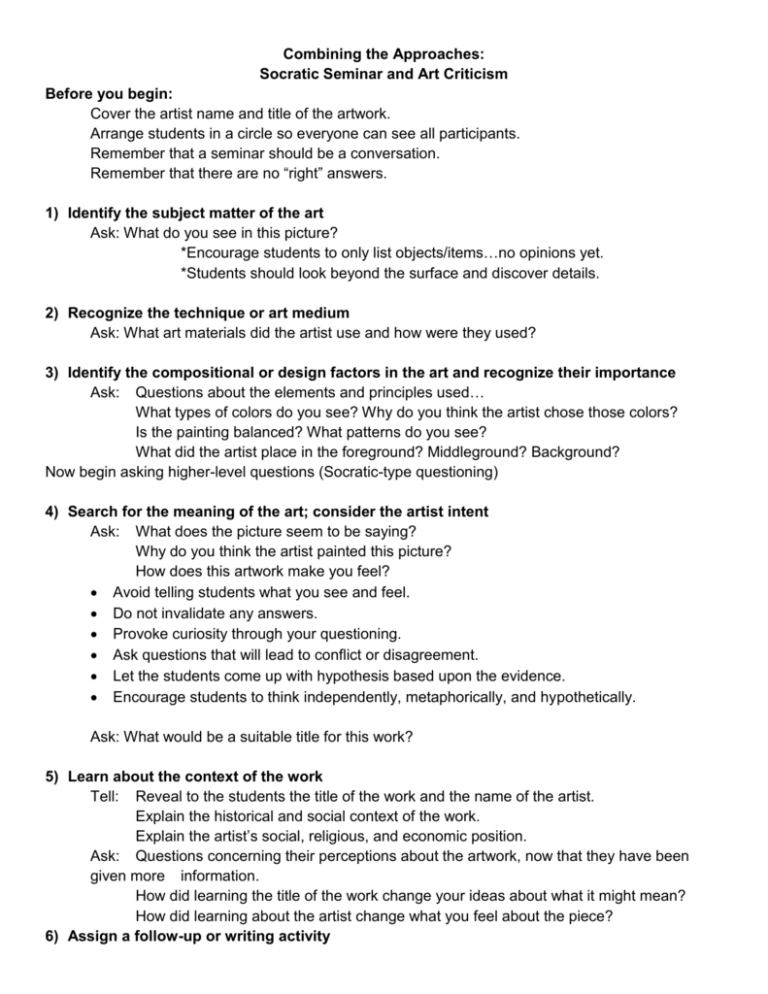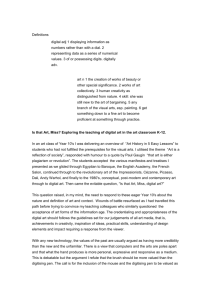Art Criticism Example
advertisement

Combining the Approaches: Socratic Seminar and Art Criticism Before you begin: Cover the artist name and title of the artwork. Arrange students in a circle so everyone can see all participants. Remember that a seminar should be a conversation. Remember that there are no “right” answers. 1) Identify the subject matter of the art Ask: What do you see in this picture? *Encourage students to only list objects/items…no opinions yet. *Students should look beyond the surface and discover details. 2) Recognize the technique or art medium Ask: What art materials did the artist use and how were they used? 3) Identify the compositional or design factors in the art and recognize their importance Ask: Questions about the elements and principles used… What types of colors do you see? Why do you think the artist chose those colors? Is the painting balanced? What patterns do you see? What did the artist place in the foreground? Middleground? Background? Now begin asking higher-level questions (Socratic-type questioning) 4) Search for the meaning of the art; consider the artist intent Ask: What does the picture seem to be saying? Why do you think the artist painted this picture? How does this artwork make you feel? Avoid telling students what you see and feel. Do not invalidate any answers. Provoke curiosity through your questioning. Ask questions that will lead to conflict or disagreement. Let the students come up with hypothesis based upon the evidence. Encourage students to think independently, metaphorically, and hypothetically. Ask: What would be a suitable title for this work? 5) Learn about the context of the work Tell: Reveal to the students the title of the work and the name of the artist. Explain the historical and social context of the work. Explain the artist’s social, religious, and economic position. Ask: Questions concerning their perceptions about the artwork, now that they have been given more information. How did learning the title of the work change your ideas about what it might mean? How did learning about the artist change what you feel about the piece? 6) Assign a follow-up or writing activity Seminar Analysis Questions Developed by Lori Cozzi, North Carolina A+ Fellow Painting: Broadway Boogie Woogie By Piet Mondrian, 1942-1943 Knowledge: What types of lines do you see in this picture? What colors do you see in this picture? What shapes do you see in this picture? What types of materials did the artist use to create this picture? Comprehension: Describe and explain what this painting reminds you of? Application: What do you think the artist intended when he painted this picture? *Reveal the title of the painting and the artist’s name. Analysis: Why do you think Mondrian named the painting Broadway Boogie Woogie? Synthesis: How does knowing the name of the painting affect the way you feel about it? Evaluation: Is this a good painting? Defend and justify your answer. Synthesis: Construct a collage in the style of Piet Mondrian’s Broadway Boogie Woogie. How to Be an Effective Seminar Leader *adapted from The Paideia Program by Mortimer Adler The Three Roles of a Seminar Leader: 1) to ask a series of questions that define the discussion and give it direction 2) to examine or query the answers by trying to draw out the reasons for them or the implications they have 3) and to engage the participants in two-way talk with one another when the views they have advanced appear to be in conflict -Remember Sometimes you will need to rephrase or paraphrase so that everyone will understand. Ask questions that cannot be answered by yes or no. Ask questions that raise issues. Ask hypothetical questions. Make sure the questions are being heard and understood. Do not accept incoherent speech or incomplete sentences or incomplete answers. Require students to restate the question in their answer. Have a list of questions prepared before you begin. Research and understand the artwork and its context. Be patient and polite. Never talk down to a student. Make an effort to understand what is going on in the minds of your students. Resources: The Art Teacher’s Book of Lists Helen D. Hume The Paideia Program Mortimer J. Adler The Story of Ruby Bridges Robert Coles Through My Eyes Ruby Bridges The Problem We All Live With Norman Rockwell Available at: normanrockwellvt.com Socratic Art Criticism Seminar Questions developed by Lori Cozzi NC A+ Fellow loricozzi@bellsouth.net Artwork: The Problem We All Live With By Norman Rockwell What things do you see in this picture? (Students should strictly list what they see without providing interpretation at this point) How was this artwork created? What materials did the artist use? Describe the colors that you see in this painting. Why do you think the artist used the colors the way he/she did? Describe the “motion” or “action” you see in the painting. Why do you think the artist cropped the heads of the men in the painting? Why do we see the entire body of the child? Use an adjective to describe the child you see. You must explain why you choose that word. What do you think is going on in the painting? How does this painting make you feel? Why do you think the artist created this painting? Write a title for this painting. (Each student should write their own title. Then ask students to share.) Reveal the name of the painting and the artist. Explain the situation represented. What do you think the little girl (Ruby) is thinking? Why? What do you think the marshal’s are thinking? Why? What do you think might be happening during this event that the artist chose not to show in the painting? Why did he leave those things out of the artwork? Improving Interpretation Skills Through Socratic Seminar Workshop developed and presented by Lori Cozzi North Carolina A+ Fellow loricozzi@bellsouth.net Socratic Seminar Socratic comes from the word “Socrates” Socrates (470-399 b.c.) was the Greek philosopher who developed the theory of knowledge. Theory of Knowledge: the surest way to attain reliable knowledge was through dialectic Dialectic: the art or practice of examining opinions or ideas logically, often by method of question and answer, so as to determine their validity. What is a Socratic Seminar? Socratic Seminar is a method to try to understand information by creating a dialectic in class in regards to specific text. In Socratic Seminar participants seek deeper understanding of complex ideas in the text through rigorously thoughtful dialogue rather than by memorizing bits of information. “The role of the teacher in a Socratic Seminar is that of a good conversationalist who primes the pump of discussion by asking leading questions and pursuing the answers given to them by asking more questions.” From The Paideia Program by Mortimer Adler Other similar strategies: Paideia Program & Junior Great Books What is Art Criticism? Two Types: 1) Portrayal Criticism- helps the viewer slow down and see what the work includes. It suggests that there is no “right way” to see an artwork. 2) Persuasive Criticism- is judgmental and argues the worth of the work. In our classrooms we should be using Portrayal Criticism methods to help students develop appreciation and understanding. Students should be asked to offer their observations and opinions and then articulate their viewpoints.









